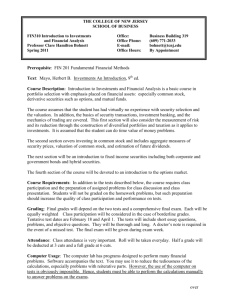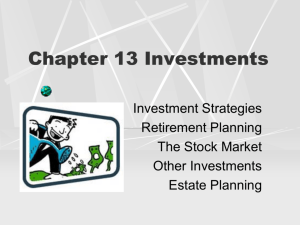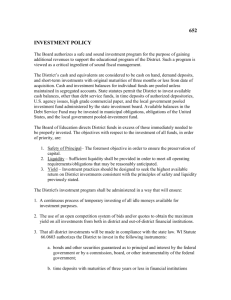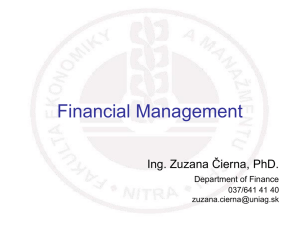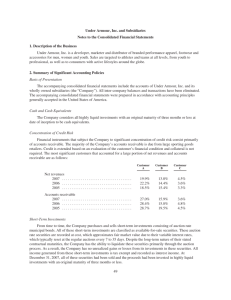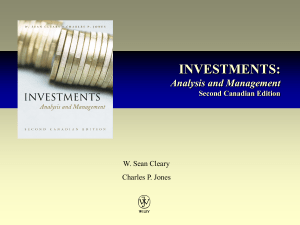Cash and Non-operating Assets
advertisement
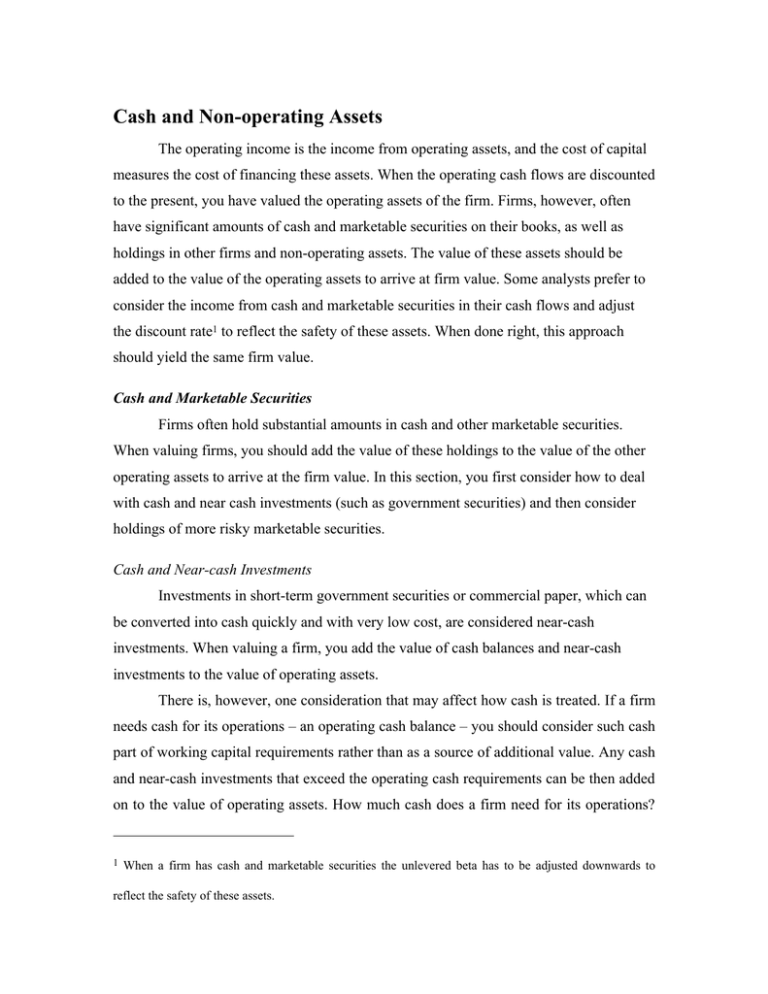
Cash and Non-operating Assets The operating income is the income from operating assets, and the cost of capital measures the cost of financing these assets. When the operating cash flows are discounted to the present, you have valued the operating assets of the firm. Firms, however, often have significant amounts of cash and marketable securities on their books, as well as holdings in other firms and non-operating assets. The value of these assets should be added to the value of the operating assets to arrive at firm value. Some analysts prefer to consider the income from cash and marketable securities in their cash flows and adjust the discount rate1 to reflect the safety of these assets. When done right, this approach should yield the same firm value. Cash and Marketable Securities Firms often hold substantial amounts in cash and other marketable securities. When valuing firms, you should add the value of these holdings to the value of the other operating assets to arrive at the firm value. In this section, you first consider how to deal with cash and near cash investments (such as government securities) and then consider holdings of more risky marketable securities. Cash and Near-cash Investments Investments in short-term government securities or commercial paper, which can be converted into cash quickly and with very low cost, are considered near-cash investments. When valuing a firm, you add the value of cash balances and near-cash investments to the value of operating assets. There is, however, one consideration that may affect how cash is treated. If a firm needs cash for its operations – an operating cash balance – you should consider such cash part of working capital requirements rather than as a source of additional value. Any cash and near-cash investments that exceed the operating cash requirements can be then added on to the value of operating assets. How much cash does a firm need for its operations? 1 When a firm has cash and marketable securities the unlevered beta has to be adjusted downwards to reflect the safety of these assets. The answer depends upon both the firm, and the economy in which the firm operates. A small retail firm in an emerging market, where cash transactions are more common than credit card transactions, may require an operating cash balance that is substantial. In contrast, a manufacturing firm in a developed market may not need any operating cash. In fact, if the cash held by a firm is interest-bearing, and the interest earned on the cash reflects a fair rate of return2, you would not consider that cash to be part of working capital. Instead, you would add it to the value of operating assets to value the firm. Other Marketable Securities Marketable securities can include corporate bonds, with default risk embedded in them, and traded equities, which have even more risk associated with them. As the marketable securities held by a firm become more risky, the choices on how to deal with them become more complex. You have three ways of accounting for marketable securities: • The simplest and most direct approach is to estimate the current market value of these marketable securities and add the value on to the value of operating assets. For firms valued on a going-concern basis, with a large number of holdings of marketable securities, this may be the only practical option. • The second approach is to estimate the current market value of the marketable securities and net out the effect of capital gains taxes that may be due if those securities were sold today. This capital gains tax bite depends upon how much was paid for these assets at the time of the purchase and the value today. This is the best way of estimating value when valuing a firm on a liquidation basis. • The third and most difficult way of incorporating the value of marketable securities into firm value is to value the firms that issued these securities and estimate the value of these securities. This approach tends to work best for firms that have relatively few, but large, holdings in other publicly traded firms. Holdings in Other Firms 2 Note that if the cash is invested in riskless assets such as treasury bills, the riskless rate is a fair rate of return. In this category, you consider a broader category of non-operating assets, where you look at holdings in other companies, public as well as private. You begin by looking at the differences in accounting treatment of different holdings, and how this treatment can affect the way they are reported in financial statements. Accounting Treatment The way in which these assets are valued depends upon the way the investment is categorized and the motive behind the investment. In general, an investment in the securities of another firm can be categorized as a minority, passive investment; a minority, active investment; or a majority, active investment, and the accounting rules vary depending upon the categorization. Minority, Passive Investments If the securities or assets owned in another firm represent less than 20% of the overall ownership of that firm, an investment is treated as a minority, passive investment. These investments have an acquisition value, which represents what the firm originally paid for the securities, and often a market value. Accounting principles require that these assets be sub-categorized into one of three groups - investments that will be held to maturity, investments that are available for sale and trading investments. The valuation principles vary for each. • For investments that will be held to maturity, the valuation is at historical cost or book value, and interest or dividends from this investment are shown in the income statement. • For investments that are available for sale, the valuation is at market value, but the unrealized gains or losses are shown as part of the equity in the balance sheet and not in the income statement. Thus, unrealized losses reduce the book value of the equity in the firm, and unrealized gains increase the book value of equity. • For trading investments, the valuation is at market value and the unrealized gains and losses are shown in the income statement. Firms are allowed an element of discretion in the way they classify investments and through this choice, in the way they value these assets. This classification ensures that firms such as investment banks, whose assets are primarily securities held in other firms for purposes of trading, revalue the bulk of these assets at market levels each period. This is called marking-to-market, and provides one of the few instances in which market value trumps book value in accounting statements. Minority, Active Investments If the securities or assets owned in another firm represent between 20% and 50% of the overall ownership of that firm, an investment is treated as a minority, active investment. While these investments have an initial acquisition value, a proportional share (based upon ownership proportion) of the net income and losses made by the firm in which the investment was made, is used to adjust the acquisition cost. In addition, the dividends received from the investment reduce the acquisition cost. This approach to valuing investments is called the equity approach. The market value of these investments is not considered until the investment is liquidated, at which point the gain or loss from the sale, relative to the adjusted acquisition cost is shown as part of the earnings in that period. Majority, Active Investments If the securities or assets owned in another firm represent more than 50% of the overall ownership of that firm, an investment is treated as a majority active investment3. In this case, the investment is no longer shown as a financial investment but is instead replaced by the assets and liabilities of the firm in which the investment was made. This approach leads to a consolidation of the balance sheets of the two firms, where the assets and liabilities of the two firms are merged and presented as one balance sheet. The share of the firm that is owned by other investors is shown as a minority interest on the liability side of the balance sheet. A similar consolidation occurs in the other financial statements of the firm as well, with the statement of cash flows reflecting the cumulated cash inflows and outflows of the combined firm. This is in contrast to the equity approach, used for minority active investments, in which only the dividends received on the investment are shown as a cash inflow in the cash flow statement. 3 Firms have evaded the requirements of consolidation by keeping their share of ownership in other firms below 50%. Here again, the market value of this investment is not considered until the ownership stake is liquidated. At that point, the difference between the market price and the net value of the equity stake in the firm is treated as a gain or loss for the period. Valuing Cross Holdings in other Firms Given that the holdings in other firms can accounted for in three different ways, how do you deal with each in valuation? 1. If the holdings are treated as minority, passive investments, and the investments are reported in the balance sheet at the original cost or book value, you would value the firm in which these holdings are, and consider the proportion of the value that comes from the holding. For instance, assume that a firm owns 20% of another firm that has an estimated value of $ 500 million. The estimated value of this holding is $ 100 million. 2. If the holdings are minority, passive investments and the investments are recorded at market value, you have one of two choices. You can assume that the market is correct and use the assessed market value of these cross-held assets to value the firm. Alternatively, you can value the companies in which the investments have been made and add the estimated value of the holdings to the value of operating assets. 3. If the holdings are minority active interests, you need to value the firms in which these holdings are, and add the proportion of that value to the value of the operating assets of the firm. 4. If the holdings are majority, active interests, the income statements are consolidated. Consequently, the operating income of the firm includes the total operating income from the subsidiary, rather than the firm’s share of the subsidiary. You estimate the value of the subsidiary and add on the portion of the value that accrues to the parent company. Where, you might ask, is the minority interest that you see on the parent company’s balance sheet? You do not use it directly, since it reflects the book value of the holdings of others in the subsidiaries rather than market value. Other Non-Operating Assets Firms can have other non-operating assets, but they are likely to be of less importance than those listed above. In particular, firms can have unutilized assets that do not generate cash flows and have book values that bear little resemblance to market values. An example would be prime real estate holdings that have appreciated significantly in value since the firm acquired them, but produce little if any cash flows. An open question also remains about overfunded pension plans. Do the excess funds belong to stockholders and, if so, how do you incorporate the effect into value? Unutilized Assets The strength of discounted cash flow models is that they estimate the value of assets based upon expected cash flows that these assets generate. In some cases, however, this can lead to assets of substantial value being ignored in the final valuation. For instance, assume that a firm owns a plot of land that has not been developed, and that the book value of the land reflects its original acquisition price. The land obviously has significant market value but does not generate any cash flow for the firm yet. If a conscious effort is not made to bring the expected cash flows from developing the land into the valuation, the value of the land will be left out of the final estimate. How do you reflect the value of such assets in firm value? An inventory of all such assets (or at least the most valuable ones) is a first step, followed up by estimates of market value for each of the assets. These estimates can be obtained by looking at what the assets would fetch in the market today or by projecting the cash flows that could be generated if the assets were developed and discounting the cash flows at the appropriate discount rate. The problem with incorporating unutilized assets into firm value is an informational one. Firms do not reveal their unutilized assets as part of their financial statements. While it may sometimes be possible to find out about such assets as investors or analysts, it is far more likely that they will be uncovered only when you have access to information about what the firm owns and uses. Pension Fund Assets Firms with defined pension liabilities sometimes accumulate pension fund assets in excess of these liabilities. While the excess does belong to stockholders, they usually face a tax liability if they claim it. The conservative rule in dealing with overfunded pension plans would be to assume that the social and tax costs of reclaiming the excess funds are so large that few firms would ever even attempt to do it. The more realistic approach would be to add the after-tax portion of the excess funds into the valuation. cash.xls: There is a dataset on the web that summarizes the value of cash and marketable securities by industry group in the United States for the most recent quarter.
